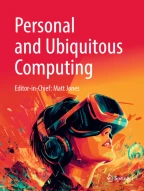Abstract
We are investigating how people move from individual to group work through the use of both personal digital assistants (PDAs) and a shared public display. Our scenario of this work covers the following activities. First, mobile individuals can create “personal” notes on their PDAs. Second, when individuals meet in real time, they can selectively “publicise” notes by moving them to a shared public display. Third, the group can manipulate personal and public items in real time through both PDAs and the shared public display, where the notes contained on both PDAs and public display are automatically synchronised. Finally, people leave a meeting with a common record of their activity. We describe our SharedNotes system that illustrates how people move through this scenario. We also highlight a variety of problematic design issues that result from having different devices and from having the system enforce a rigid distinction between personal and public information.
Similar content being viewed by others
References
Norman DA. The invisible computer. MIT Press, Cambridge, Mass., 1998
Tang JC. Findings from observational studies of collaborative work. International Journal of Man-Machine Studies, 1991; 34(2):143–160
Luff P, Heath C. Mobility in collaboration. In: Proceedings of ACM CSCW'98 Conference on Computer-Supported Cooperative Work, ACM Press, New York, 1998: 305–314
Siegel J, Kraut R, Miller M, Kaplan D, Bauer M. Collaborative wearable systems research and evaluation. In: Video Program. Video program: Proceedings of ACM CSCW'96 Conference on Computer-Supported Cooperative Work, ACM Press, New York, 1996: 9–10
Kraut R, Miller M, Siegel J. Collaboration in performance of physical tasks: effects on outcomes and communication. In: Video Programme: Proceedings of ACM CSCW'96 Conference on Computer-Supported Cooperative Work, ACM Press, New York 1996: 57–66
Davis R, Lin J, Brotherton J, Landay J, Price M, Schilit B. A framework for sharing handwritten notes. In: Proceedings of the ACM Symposium on User Interface Software and Technology, ACM Press, New York, 1998: 119–120
Minenko V. Palm VNC: virtual network computing client for palm platform. http://www.icsi.berkeley.edu/∼minenko/PalmVNC/, 1998
Bharat K, Cardelli L. Migratory applications. In: Proceedings of the ACM Symposium on User Interface Software and Technology. ACM Press, New York, 1995: 133–142
Richardson T, Bennett F, Mapp G, Harter A, Hopper A. Teleporting—making applications mobile. In: Video Program. Proceedings of ACM CSCW'94 Conference on Computer-Supported Cooperative Work, ACM Press, New York, 1994: 9–10
3Com Corporation. Palm Pilot Handbook. Part number 423-0210-01C. 1565 Charleston Rd., Mountain View, Calif. See also www.palm.com, 1994
Lotus Notes Inc. Lotus EasySync, version 2.1. Lotus Development Corporation, Cambridge, Mass., 1998
Johnson C. The impact of time and place on the operation of mobile computing. In: Proceedings of the HCI'97 Conference on People and Computers XII, 1997: 175–190
Kawachiya K, Ishikawa H. NaviPoint: an input device for mobile information browsing squeezing, stroking and poking. In: Proceedings of ACM CHI' 98 Conference on Human Factors in Computing Systems, ACM Press, New York. 1998: 1–8
Rekimoto J. Pick-and-drop: a direct manipulation technique for multiple computer environments. In Proceedings of the ACM UIST '97 Symposium on User Interface Software and Technology, ACM Press, New York, 1997: 31–39
Roseman M, Greenberg S. Building real-time groupware with GroupKit, a groupware toolkit. ACM Transactions on Computer Human Interaction, 1996; 3(1):66–106
Smart Technologies, Inc. Calgary, Alberta, Canada. www.smarttech.com
Myers B, Stiel H, Gargiulo R. Collaboration using multiple PDAs connected to a PC. In: Proceedings of the ACM CSCW '98 Conference on Computer Supported Cooperative Work. ACM Press, New York, 1998
Greenberg S, Boyle M. Moving between personal devices and public displays. In: Workshop on Handheld CSCW, held at CSCW'98. Available as Technical Report, Department of Computer Science, University of Karlsruhe, Germany. http://www.teco.edu/hcscw/program.html, 1998
Author information
Authors and Affiliations
Corresponding author
Rights and permissions
About this article
Cite this article
Greenberg, S., Boyle, M. & Laberge, J. PDAs and shared public displays: Making personal information public, and public information personal. Personal Technologies 3, 54–64 (1999). https://doi.org/10.1007/BF01305320
Issue Date:
DOI: https://doi.org/10.1007/BF01305320
